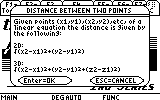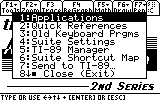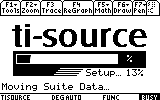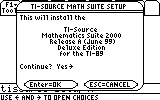|
MSuit 2000
|
|
FILE INFORMATION
Ranked as 1812 on our all-time top downloads list with 11890 downloads.
Ranked as 7141 on our top downloads list for the past seven days with 1 downloads.
SCREEN SHOTS




REVIEWS
|
Review
|
|
Review by
|
 Devin Bayer Devin Bayer
|
|
Reviewed on
|
2004-11-22
|
Suitability: 7/10 Can't customize, huge file, limited
Ease-Of-Use: 10/10 Best Readme ever, on-calc help
Overall: 9/10 Tons of features-Very sleek
This is a very professional program. There is an about box for every program and sub-program. Kinda like something you might expect MS to release for the TI-89. Loaded with features and some error handling, but not bug proof. There are two versions of this program included in the .zip: Deluxe and Mini. The Deluxe is bigger, taking up about 80,000 bytes. The mini version takes up 50,000 bytes and is missing some features. This review is focused on the Deluxe version only, because for obvious reasons I didn't want to try both out when they are almost identical. I would like to put in a good word for the readme. Available is 4 versions, (.89t (on calc readme), .txt, .doc, and .wps) it is by far the most informative and best-organized readme I've ever seen. There are almost 20 pages of screenshots and examples along with a few short math lessons. This review will just follow the readme. First, installation:
Installation went smoothly. Couldn't be more user friendly or powerful. But it could have some versatility. You start out with terms of agreement and a dialog to enter your name for registration. Cute, but not all that useful. Then it takes a few seconds to unlock all the functions and programs, copy them to the right spot, and archive most everything. Even though the prog takes up 80k, only about 1k of RAM is used. This is really cool. They don't skimp on graphics here either, with a logo screen containing a status bar during installation. 1 thing I don't like about this is that it copies many functions and Keyboard programs to the main folder, without asking. I would rather have all my math functions in a MATH folder, but what are you gonna do. All your old keyboard progs are copied to an OLD_MAIN folder and can be accessed later with the manager (Keyboard Program 5).
Keyboard Program 1: Quadratic Equation Tool - Not as graphical as some other programs. Given the equation (a)x^2+(b)x+(c), you enter variables for a, b, and c. Then it solves the roots, finds the discriminant or vertex, or graphs them. The graphing never worked for me. I always got an abnormal program termination message after it was graphed. The answers for x1 and x2 are given in the Program IO screen and if they are too long they get cut off. Besides these points it worked fine.
Keyboard Program 2: References Center - this is a reference center for the included functions and their syntax, plus a library of other equations and laws that are commonly used and often hard to remember. They are arranged alphabetically and there are about 30 of them. I find this feature useful, but it needs to cover more topics. Some examples of reference topics include: Distance (Linear) for both 2d and 3d, Half Angle form, Midpoint, Parabola, Triangles, Sum and Difference, and Identities. There is one time that I got caught in an endless loop by not being able to exit by pressing ESC. This happens when you use this popup menu to go to the suite manager, then the suite manager to go to the Reference Center.
Keyboard Program 3: Simultaneous Equation Solver - Just a more friendly way to enter Simult Eqns. Then the TI-OS function. It uses the built it function, so the answers are always the same, but works like the TI-85/86 so it is easier to see what you are doing. The answers are displayed in Pages, with the ability to move problem by problem and page by page. You can save the variables and the answer as expressions like all the other function in this suite. All the answers can be saved in a matrix format.
Keyboard Program 4: Linear Equation Utility - This works for either 2D or 3D equations. You enter an ordered pair and it figures the slope, intercepts, midpoint, and distance. Then you can graph the equation or the line segment. I would use this utility all the time, except that whenever I enter a variable, it results in an abnormal program termination. This isn't an OS problem because I've made my own functions that do not result in an error when I enter a variable. Works great for #'s however.
Keyboard Program 5 : Suite Manager - here you can access all the suites programs, old keyboard programs, or the shortcut map for what each of the current suite keyboard programs do. There is also a TI89 manager. In the TI89 manager you can create a new folder, clear the graph, home, and I/O screens, or find the amount of memory/archive used and free. There is a bug in the memory part, because the Total Memory Usage shows 78% when it also says I'm using only 130f Archive and 4110000057110f RAM. I think this may mean Total Memory Free. In the TI89 manager you can also uninstall the Suite, Rerun the setup, or rebuild the files (I think this just registers you under a different name.). Then there is the Suite Setup. The main focus of this is to define a custom menu. It isn't a custom menu creator, though. There are 3 pre-programmed custom menus. The default one (that comes with the TI), a suite specific one, and one for BASIC programmers. The latter is nifty, but doesn't have the nested menus that come with the calc. This setup can also turn suite graphics on/off. But why would anybody want graphics to be off? The Suite manager can also send the entire suite to another calc. I couldn't test this, because I don't have another TI-89 nor does anybody I know.
Keyboard Program 6: Numerical Converter - Converts temperature and bases. Supports BCD, Bin, Dec, Hex, Oct, Celsius, Fahrenheit, Kelvin, and Rankine. First, enter the initial base, then the desired base, enter the value, and hit ENTER. That is it. Easy to use and works.
Keyboard Program 7: Geometry Toolbox - here you will find various geometry (duh) and trigonometry tools. First off, the triangle solver. This is useful for finding the side lengths and angles of a real triangle. You enter values for 3 angles and 3 sides except the ones that you don't know. Select degrees or radians and exact or approximate mode. After execution, these settings will be set back to their original state. Then it takes a while to calculate all the side and angle measurements of the triangle. This is useful, but again, like in the Linear Utility, variables are not supported. This is a real bummer because as you know, in math class you don't always have the real measurements of the triangle. NEXT: Solver info. This is just directions on how to use the triangle solver. NEXT: Area and volume. Guess what? It supports variables! Finally some common sense. But wait, there are only 5 figures. Too bad, because this would have been really great if it had more than a circle, a parallelogram, a triangle, an equilateral triangle, and a sphere. Works fine; straitforward. But it can't do backward solving. What I mean is, if you know the area of a circle, you can't find the radius. NEXT: Pythagorean theorem. Solve for a, b, or c in a^2+b^2=c^2. Also lets you view the equation. Supports variables!
Keyboard program 8: Character viewer - I'll try to be brief. Good for Basic programmers. Enter a # and it will tell you what character it corresponds to. Also scroll 1 by 1 up or down.
Ketboard program 9: Application map - shows a dialog what tells what keyboard program corresponds to what part of the Suite.
THAT'S IT FOR KEYBOARD PROGRAMS. Now for the included functions
There are 4 included functions in the Deluxe Version. First is the Binomial Expander. A binomial is a 2-part algebraic expression like (5x-6y)^4. The function works like this: binexp(5x,-6y,4) returns 625x^4-3000x^3y+5400x^2y^2-4320xy^3+1296y^4. The next function is a Logarithmic Utility. Evaluates logarithms at values other than base 10. With a base 2, logb(2,5) would return 0.430677. Then there is a Triangle Solver. A, B, and C are the angles and a, b, c are the sides. This works the same as the Program in the Geometry Toolbox. Syntax: triSolve(A,B,C,a,b,c). Undef is used for unknown variables. The result is given in a list of strings as follows: {"angle a=45" "angle b=28.1255" "angle c=106.874" "side a=12" "side b=8" "side c=16.2399"}. Then there are 6 trig functions. They only take one argument. They do co-tangent, co-secant, secant, co-tangent^-1, co-secant^-1, and secant^-1.
Some final notes: The save variable dialog boxes, available in all programs, are just like those used by the TI-OS but there is no way to retrieve the information in the programs, so they are not as useful as they could be. Although the creator prides the error handling and easy escaping, it could be improved. Nothing is too bad to lessen my opinion of this fabulous program, though. The suite sets a lot of values like modes and window settings without asking, often not changing them back. This can be annoying and actually decreases the value of this program because you cannot, say, get an approximate answer for the distance of a line with the Linear Solver. There is an uninstall feature that doesn't quite work, so I didn't mention it under the TI89 Manager section. This program was tested on AMS2.03 and I think that it makes a little difference because I got some errors the author didn't mention. Even if you don't use the entire suite, some parts may be useful and I believe that this is a worthy download. |
|
LEAVE FEEDBACK
Questions, comments, and problems regarding the file itself should be sent directly to the author(s) listed above.
Write a review for this file (requires a free account)
Report inappropriate or miscategorized file (requires an account; or you may email us directly)
If you have downloaded and tried this program, please rate it on the scale below
ARCHIVE CONTENTS
|
Archive Contents
|
|
Name
|
Size
|
| Readme.wps | 1826816 |
| MSuit20m.89g | 51864 |
| README.89T | 38540 |
| Readme.doc | 4331707 |
| Readme.txt | 52926 |
| MSuit20d.89g | 83327 |
|
|
|
|
|

